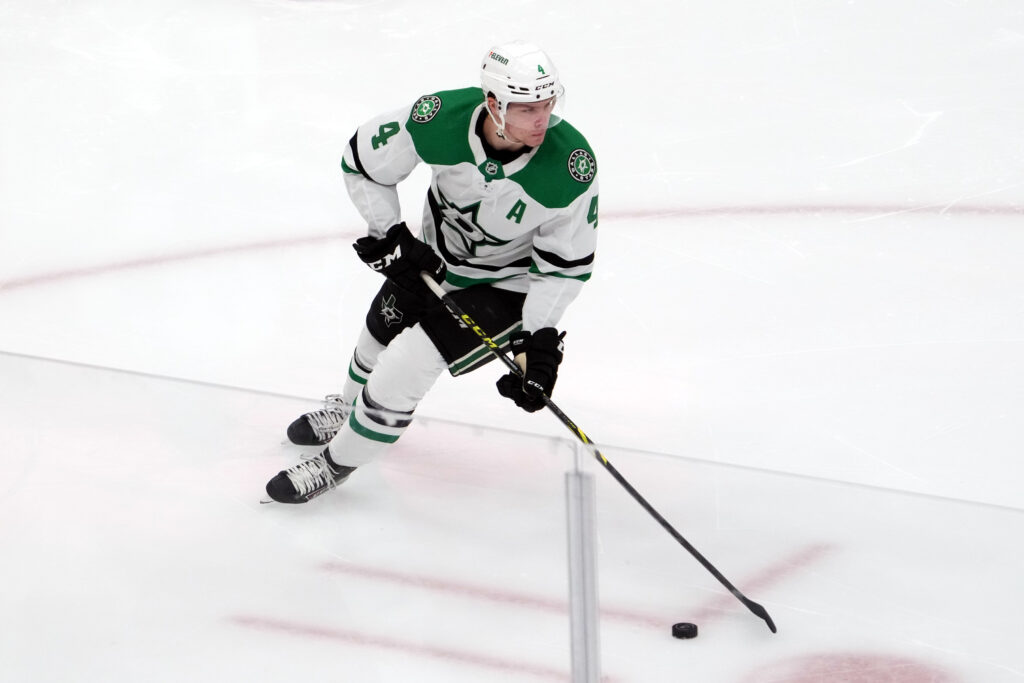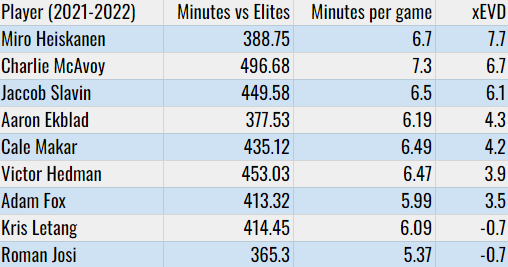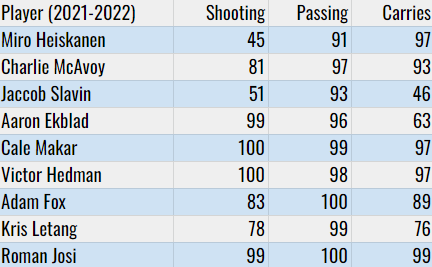One of the fun things we get to do as the season winds down is discuss who does or doesn’t deserve hockey’s Oscars. Just last week, Dallas had front-row seats to Auston Matthews figuratively and literally running away with the Rocket Richard Trophy for most goals in a season. The Stars, meanwhile, have not done anything quite so spectacular. Nobody on Dallas’ roster is in the running for the Vezina (best goaltender), the Calder (best rookie), the Art Ross (most points), or the Hart (most valuable player). There is, however, one award we can talk about: the Norris trophy, given to the league’s best defenseman. And, yes, Miro Heiskanen belongs in that discussion.
This would have been expected in the fall, when Heiskanen opened the season by scoring the overtime winner in Dallas’ first game, the sort of statement goal that voters salivate over (in spite of the Norris being a defensive award). Then, in November, he was the talk of hockey when the world saw him shut down Connor McDavid. Since then, you’d be hard-pressed to call Heiskanen’s 2021-22 campaign “spectacular.”
But that’s not to say it’s been bad. Sure, he hasn’t scored a goal since December, and he has just two assists since the beginning of March. He’s also eighth on the team in power-play scoring, but it’s probably safe to presume he was fighting his bout with mononucleosis before and after his 11-game absence to bookend what has been a relatively quiet season.
Still, despite these obstacles, Heiskanen has a case. Before I make it, let’s set the table for how we define “good defense.” Below, you’ll see a table of the top nine Norris frontrunners. I’m interested in answering two basic questions: how difficult are their minutes, and what kind of defense does the team get from those minutes?
I think that’s a good starting point because defensemen play the most minutes, and their primary job is to defend. If those minutes are tough, and opponents don’t score, that’s a good base. Per PuckIQ and Evolving-Hockey, we get to see Heiskanen’s minutes versus elite competition and the amount of goals we should expect the team to prevent with them on the ice (xEVD). Here’s how Heiskanen grades out against his Norris-caliber peers.
Two things stand out: Heiskanen plays the second most minutes against elite competition per game, and he leads all Norris candidates in expected goals prevented. Does this make him the best defender? No. Does this make him the best defensive defenseman? A case can certainly be made. After all, that’s nearly eight extra goals Dallas is expected to allow without Heiskanen on the ice (!).
Let’s quantify Heiskanen’s defensive performance another way. How does Dallas defend without him? The Stars went 11 games with Heiskanen on the shelf. Their record was a modest 6-5 without Heiskanen in March, but the record doesn’t reflect how Dallas was performing within those games. Which, judging by shot attempts given up (CA/60), shots on net against (SA/60), scoring chances (SCA/60), high-danger chances (HDCA/60), goals against, and expected goals against, was absolutely dreadful.
With Heiskanen, the Stars are a good (though not quite elite) defensive team that controls the home plate area of the ice—shots allowed in this area are what define scoring chances—and the crease better than most. However, they were a disaster without him. They graded poorly in every category, dropping 15 spots in high-danger shots allowed and 20 in expected goals allowed. Looking at these splits, you could argue that not only does Heiskanen compare favorably to his peers, but I’m not sure there’s a defender more important to his team’s success than he is to Dallas’.
But there’s another side of the coin: offense. Most Norris winners score a lot of points. This phenomenon has become a point of contention. Hockey insider Pierre LeBrun recently polled all 32 NHL coaches on who should win the Norris, and one coach submitted an atypical ballot. When asked, the coach responded, “I’ve never understood why we judge DEFENCEmen [sic] based on what they do on OFFENCE [sic].”
Well, there’s a synthesis for it. Offense is harder to create from the back end, and anybody who does has to be exceptional at it. Defenders activate the charge and start the chain reaction of movements across all three zones to control play. Every goal they score, every pass that makes it into the box score, and every play that gains their team territory is successful management of puck possession. So of course offense is critical. Defenders play the most minutes in the most crucial scenarios in all situations. If they are not helping control the scoresheet within those minutes, whether actively or passively, then the team isn’t winning.
Below, you’ll see how Heiskanen compares to his Norris peers. Like with defense, I’m interested in answering two basic questions: how effectively do these players start the offensive chain of events, and how well do they finish them?
Per ARHockeyStats and Corey Sznajder, we get to see what percentile Heiskanen belongs in compared to his peers when it comes to shooting the puck, passing the puck, and controlling the puck through the neutral zone.
While Heiskanen remains elite, he clearly lags behind in these categories, albeit not as much as you might think. In terms of converting shots into goals, he’s only better than 45 percent of the players at his position. His passing is special, but his top-end peers are even better. He is, on the other hand, better than 97 percent of the league’s defensemen when it comes to successfully carrying the puck through the neutral and into the offensive zone. Only Cale Makar, Victor Hedman, and Roman Josi are as good or better.
In other words, Heiskanen is a Norris-level player. But he’s still shy of more actively controlling the scoresheet, and the Norris will always be left to those that do both.
Is Heiskanen capable of that? I think so, and I’ve argued as much. His rookie year was a testament to that. In fact, Heiskanen outperformed Makar, the current gold standard among offensive blueliners, in expected goals during their respective pro debuts. This isn’t or shouldn’t be that shocking: Heiskanen is the youngest defender in the history of Liiga (the Finnish professional league from where he was drafted) to score four or more game-winning goals, so he has it in him to be the right kind of selfish. (He scored 11 total in his post-draft year, which is a lot more than it sounds when you consider that Liiga is a professional league, and young talents don’t get showcased unless they’ve forced their coach’s hand.)
Until he does, however, he’ll remain on the periphery of the Norris conversation. In 2022, I’d expect Josi, Hedman, and Makar to be the real shortlist, with Makar, Moritz Seider, and Rasmus Dahlin positioned to be Heiskanen’s long-term competition in years to come. The defense is already there, which is a huge feat for a player who doesn’t turn 23 until July. That alone puts Heiskanen in the conversation among the NHL’s best defenders. If the Stars can unlock more of his offense, his trophy case will match the reputation.
Author










